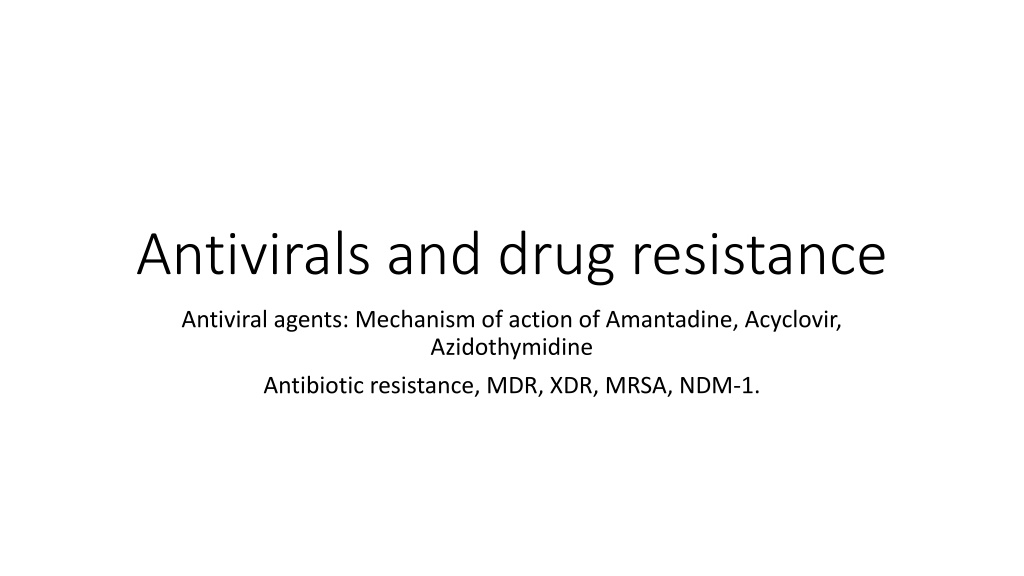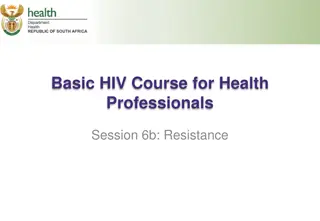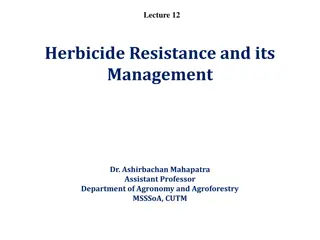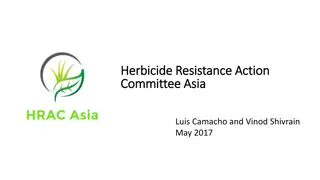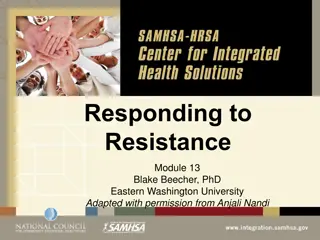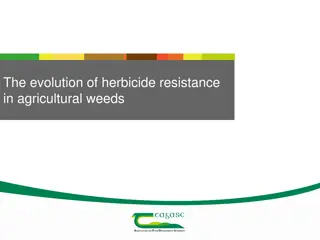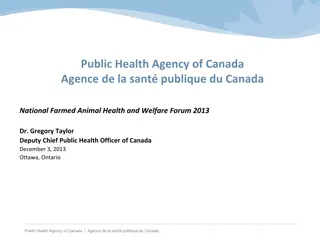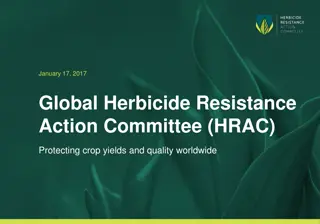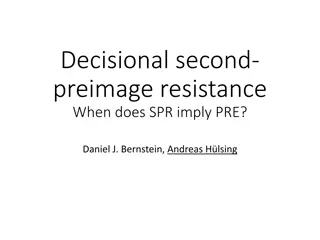Understanding Antivirals and Drug Resistance in Microbiology
Antiviral agents like Amantadine, Acyclovir, and Azidothymidine, as well as antibiotics, play a crucial role in combating drug resistance. The emergence of multidrug-resistant pathogens, such as MRSA, NDM-1, and XDR strains, presents challenges in treatment. Various drug categories from first-line to third-line drugs are utilized to address different levels of resistance, with a focus on treating conditions like tuberculosis and infections caused by resistant bacteria.
Download Presentation

Please find below an Image/Link to download the presentation.
The content on the website is provided AS IS for your information and personal use only. It may not be sold, licensed, or shared on other websites without obtaining consent from the author. Download presentation by click this link. If you encounter any issues during the download, it is possible that the publisher has removed the file from their server.
E N D
Presentation Transcript
Antivirals and drug resistance Antiviral agents: Mechanism of action of Amantadine, Acyclovir, Azidothymidine Antibiotic resistance, MDR, XDR, MRSA, NDM-1.
First line drugs : eg TB can be treated effectively by using (FLD) isoniazid (INH), rifampin (RIF), pyrazinamide (PZA), ethambutol (EMB) and streptomycin (SM). Second line drugs are the TB drugs that are used for the treatment of drug resistant TB. The second line drugs include levofloxacin, moxifloxacin, bedaquiline, delamanid and linezolid. Third-line : newer generation drugs eg NNRTIs like etravirine (ETV), boosted PIs like ritonavir boosted darunavir (DRV/r), and integrase inhibitor raltegravir (RAL)
Multidrug resistance (MDR): pathogens resistant to most of the first line of defence drugs MD Gram-negative bacteria (MDRGN bacteria) : ESKAPE pathogens Gram-negative bacteria with resistance to multiple antibiotics. Pose a serious and rapidly emerging threat for hospitalized patients particularly ICUs: correlated with increased morbidity, mortality, and prolonged hospitalization. Thus, not only do these bacteria pose a threat to global public health, but also create a significant burden to healthcare systems NDM-1 (New Delhi metallo Beta Lactamase): makes bacteria resistant to a broad range of beta-lactam antibiotics including the antibiotics of the carbapenem family, mainly used in the treatment of antibiotic-resistant bacterial infections. The gene for NDM-1 is one member of a large gene family that encodes beta- lactamase enzymes called carbapenemases. Bacteria with carbapenemases are referred to as "superbugs" because infections caused by them are difficult to treat. Such bacteria are usually sensitive only to polymyxins and tigecycline
Methicillin-resistant Staphylococcus aureus (MRSA) is any strain of S. aureus that has developed, through horizontal gene transfer and natural selection, multiple drug resistance to beta-lactam MRSA is responsible for several difficult-to-treat infections In humans. MRSA -lactam antibiotics include some penams (penicillin derivatives such as methicillin and oxacillin) and cephems such as the cephalosporins. Strains unable to resist these antibiotics are classified as methicillin-susceptible S. aureus, or MSSA. MRSA : common in hospitals, prisons, and nursing homes, where people with open wounds, invasive devices such as catheters, and weakened immune systems are at greater risk of HAIs. MRSA began as a hospital-acquired (HA-MRSA) infection but has become community-acquired (CA-MRSA), as well as livestock-acquired (LA-MRSA). XDR: extensively drug resistant eg Mycobacterium tuberculosis, defined by resistance to both rifampin and isoniazid, as well as to fluoroquinolones plus an injectable agent Total drug resistance: resistance to all the available therapeutic options
Antivirals Amantidine - Ion channel blocker 1. Mode of action it prevents the acidification of endosome which prevents the conformational change in viral membrane , hence preventing fusion of viral membrane with endosome. In short it prevents secondary uncoating. It also inhibits virus maturation by inhibiting the M2 protein needed in viral maturation. Rimantidine and Zimantidine has same mode of action just its structure is different.
3)AZT(azidothymidine) :- Better known as Zidovudine Analogue of thymidine. is a nucleoside analog reverse transcriptase inhibitor. It was the first approved treatment for HIV Mode of action:- gets phosphorylated in the cells Inhibits HIV DNA synthesis by reverse transcriptase as it lacks 3 OH. easily enters the cell as it more lipophillic due presence of azido group. Sometimes get integrated in cellular DNA, but it inhibits RT more efficiently.
2) Acyclovir is a guanosine analogue. used for treating HSV and Herpes zoster infections. it is extremely selective low in cytotoxicity. Pharmacologist Gertrude B. Elion was awarded the 1988 Nobel Prize in Medicine, partly for the development of aciclovir. Can be used both orally and also topically.
Mode of action:- it contains only a partial nucleoside structure: the sugar ring is replaced by an open-chain structure. gets phosphorylated by TK and forms Acyclo-GTP , ---- a potent inhibitor of viral DNA polymerase(as it doesn t have 3 OH) 100 times greater affinity for viral than cellular polymerase Gets incorporated into viral DNA, resulting in chain termination
